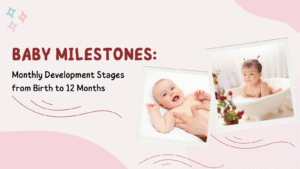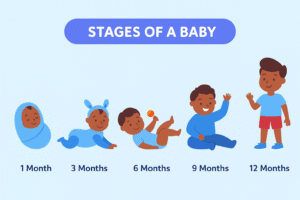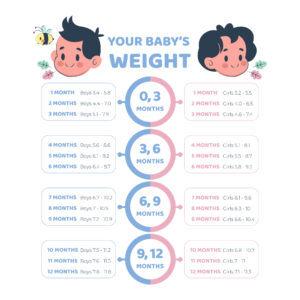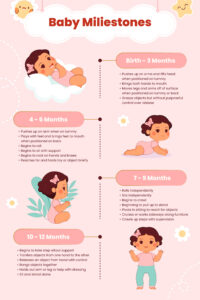
Watching your baby grow can be an exciting mix of excitement and fear. As parents of a newborn, you naturally wonder whether your child is growing in the way you expect. Baby milestones aren’t huge, but they’re significant indicators of your baby’s development, like the first time they smile or sit up, or take their first steps.
In this blog, we’ll explain the way babies develop month-to-month and when it’s time for parents to seek assistance.
Baby Milestones by Month—A Comprehensive Guide
Newborn (0-1 Month)
For the first couple of days, the baby is mainly asleep, is fed, and is adjusting to life outside of the womb. You’ll see little reflexes such as how they shiver at the sound of a loud noise or tilt their head when you gently rub their cheeks. This is called “the rooting reflex.”
Their vision isn’t fully developed, and they may only see objects in close proximity. They may be triggered by sounds or cause blinking. However, don’t anticipate much response at this point. Sleeping and feeding will take up all of their day (and at night), and patterns are still being formed.

1 Month
At the point that your baby turns one month old, it is possible to notice tiny but noticeable changes. They could begin focusing on their faces, and especially on those that are yours. The head will shift from side to side while they slowly stare at the world. The sound of your voice or a nearby sound could draw interest for the very first time. These small reactions might not sound like much; however, they’re significant stages in your baby’s development.
2 Months
When your baby is two months old, you’re likely to see the first real smile. Baby may also start making soft sounds of cooing, which is a cute way to show they’re able to communicate. In tummy time, they’ll be attempting to raise their head up a little more, even if it’s only for a moment. This helps strengthen neck muscles and helps them prepare for the next stage.
3 Months
At this point, your child will begin to follow things with their eyes, like a moving toy, or even your face when you move side-to-side. They’ll begin playing by using their hands, moving, and then closing their hands more frequently. If you keep them upright, they will be able to push with their legs, displaying the first indications of strength and control.
4 Months
There will be more babbling, and your baby will attempt to replicate the sounds that surround them. They could move from their stomach towards their back. Their hands are open to toys, demonstrating greater control and curiosity within the environment. They will learn by playing, touching, and making sounds.
5 Months
This month, expect plenty of belly laughter and plenty of interaction. Your baby is likely to hold their head with a steady grip without moving. They will begin to recognize familiar faces and show extra smiles to parents, grandparents, and their children. They’ll be more aware of those in their vicinity, and you’ll notice that the recognition will show in their faces.
6 Months
After six months, many babies begin rolling in both directions. They may even try to scoot a little. A lot of them can be seated with some support, like between cushions or even on your lap. If you call your name, they will turn towards you. This is when the baby is able to recognize you gradually.
7 Months
The baby might sit without assistance and lean forward to grasp toys. They might even try crawling or pushing themselves forward or to the side. They also have more curiosity. Children at this age are eager to play with objects, smash them against each other, or drop them to observe what happens.
8 Months
It’s a great month to have fun. Games like peek-a-boo are hugely popular, and kids laugh each time. It’s easy to see them moving items from one hand to the next with greater coordination. When you say “no,” they might be hesitant or appear confused. This is a sign that they’re beginning to comprehend tone and communication.
9 Months
Your child may now stand and hold onto furniture. This stage is filled with energy and motion. They are aware of the permanence of objects and know that the toy is still there even if it’s not visible. They often point at objects they like as a way of trying to communicate before they can speak.
10 Months
The act of standing up to stand is normal, and your child may start to play on furniture. Their voices become more varied, and they can play using different sounds. Exploration is their main goal, and they’ll want to explore everything, so child-proofing becomes crucial during this time.
11 Months
Many infants are now sailing with confidence and might even let go for a few seconds or so. It’s likely that they’re trying to imitate the sounds of speech, even though they’re not yet able to speak clearly. They will also begin to recognize simple words such as “no,” “milk,” or “bye-bye.” Their understanding is growing every day.
12 Months
Some infants may start walking by their first birthday, whereas others may still prefer to crawl. Whatever the case, it’s normal. You’ll likely hear words of a basic nature. There are also clear preferences for people, toys, and food. The expression of emotions also increases, as you can anticipate smiles, happy claps, or even sly smiles.

How to Track Baby Milestones Effectively?
There is nothing fancy to keep track of your child’s development. A simple notebook or mobile app will suffice. Simply note down when your baby smiles and rolls over, squirms or sits up, or begins babbling. These tiny observations aid in keeping track of your baby’s progress and can be helpful for doctor visits.
If you’re more tech-savvy and into technology, there are many mobile apps available that show milestones for babies and provide gentle reminders. Some even let you upload pictures or videos so you can look back later. In your home, you may just pay attention to the things your baby is doing. These tiny actions provide information about their growth as well.
One thing to keep in mind is not to be stressed that your baby doesn’t do exactly what a baby of the same age is doing. The growth of no two babies is at the same rate. Take advantage of the little shifts and celebrate each day as they unfold.
When to Talk to a Pediatrician?
Although every baby’s development is different, there are occasions when it’s best to speak with an expert. If your child isn’t smiling at three months old or doesn’t respond to sounds or isn’t sitting up with a support system by 7 months, and you’d like to check with a specialist, it’s worth raising the issue. Many issues can be resolved when you have the right support. Parents are usually aware of what is wrong, and you should rely on that.

Conclusion
The first year of life is full of major shifts, and baby milestones demonstrate how your child’s development is progressing. Although the timeline might differ for every child, the main thing is that they’re loved and cared for and regularly examined by an experienced pediatrician.
Here at Avasa Hospital, we understand the importance of how unique and difficult this process can be. This is why our team of pediatric specialists will be there to help you through each stage. It could be answering questions, assisting with charts of growth, or providing assistance when you feel unclear. If you’re ever feeling uncertain or want to confirm that you’re on the right track, you can always call us. We’re here for you and your baby at every stage of your journey.

